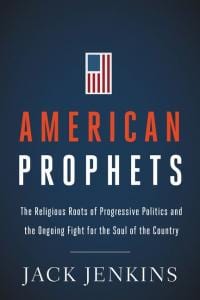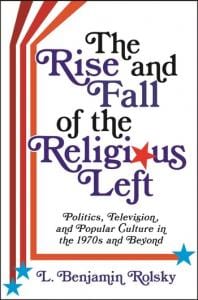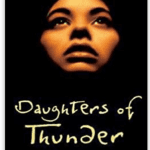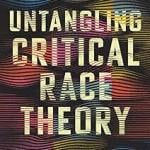Today we’re happy to welcome L. Benjamin Rolsky to The Anxious Bench. A part time lecturer at Rutgers University in religion and an adjunct professor in history and anthropology at Monmouth University, Benji just published The Rise and Fall of the Religious Left: Politics, Television, and Popular Culture in the 1970 and Beyond with Columbia University Press. In today’s guest post, he responds to Jack Jenkins’ new book on the Religious Left, American Prophets (HarperCollins, 2020 — previously reviewed here by Philip).
A Reckoning

From Standing Rock, North Dakota to the innermost circles of the Washington Beltway to the beginnings of a renewed American sanctuary movement to Catholic nuns riding buses, religion journalist Jack Jenkins introduces his readers to an eclectic collection of voices that as a whole make up the Religious Left.
Jenkins’ selection of “faith leaders” as chapter drivers, including pastor William Barber and former president Barack Obama (along with his faith engagement directors), speak to the movement’s diversity as well as to the book’s overarching structure. In addition to using such figures to shape his narrative, Jenkins also emphasizes certain themes through the actions of his chosen leaders of faith. These themes arguably serve as the most foundational concerns of the Religious Left in American public life today: health care, institutionalized racism, LGBTQ rights, the environment, and immigration just to name a few.
Broadly speaking, Jenkins’ text documents what he identifies as the “prophetic tradition of social justice” that is discernible within progressive movements of faith. With historical precedents dating back to the evangelical movements of the early 19th century and to the Social Gospel movement itself, the Religious Left makes use of an amorphous community structure in order to make change from the bottom up. “Far from being a historical relic,” Jenkins contends, “the Religious Left I have come to know exerts growing influence on modern Democratic politics — be it staging massive protests, leading legislative fights, training future candidates, or pressuring political leaders. The Religious Left is the beating heart of modern progressivism” (3). In identifying the networks of collaboration that make formations like the Religious Left possible, Jenkins ultimately hopes to show how the Religious Left is fundamentally different from the Religious Right by focusing on the intersections of protest, policy, and politics.
Perhaps most importantly, Jenkins’ encourages us to appreciate how important storytelling is to progressive modes of knowledge making and organization in the public square. As sociologist Arlie Hothschild reminds us, deep stories inform the politics of both conservative and liberal social actors in their attempts to understand one another amidst some of the worst forms of polarization ever experienced in American history. For progressives, the public square reflects their commitment to notions of the public good, fairness, and justice, Over time, marauders approach the square, looking to privatize it in the name of the free market and private enterprise.
From the vantage of 2020, those initially on the outside looking in, the conservatives in this story, seem to have transformed the once public square into a less regulated “public,” or counterpublic, in an attempt to undermine common sense assumptions about the government’s role in the everyday lives of the American people. In this sense, the once powerful New Deal state has been reduced down to a swamp in need of a better drainage system. For Jenkins, what progressive persons of faith have attempted to do to combat these less-than-desired developments in public life serves as reason enough to pursue the contemporary practices and historical examples of progressive moments of religious activism as the explicit work of American prophets.
For Jenkins, the Religious Left is categorically different from the Religious Right because of how it organizes itself. “Instead of standing alone as an isolated voting bloc, a la the Religious Right,” Jenkins explains, “the vast and complex faith-rooted organizing apparatus [William] Barber helped create often functions as a particularly vocal element within broader progressive campaigns- a sort of coalitions among coalitions” (74). Not only does this formation allow for a more decentralized form of organizing, it also makes possible broad cooperation not only with similarly interfaith Christian groups, but also with organizations and individuals connected to different religions entirely, including Sikhism, Judaism, and Islam.
 The paradigmatic example of Religious Left activism in American Prophets takes place in the name of the stranger and spaces of sanctuary. Along with chapters on environmental justice and the Black Lives Matter movement, Jenkins’ text explores what he calls the “new sanctuary movement” of the twenty-first century in order to illuminate the ways in which religious commitments inform progressive politics-making on behalf of the potentially displaced. “To understand the New Sanctuary movement is to understand how the Religious Left builds power through a mixture of moral arguments, liberation theology, and the art of protest,” contends Jenkins. “The secret to the scalability of the New Sanctuary movement lies in its appeal to the poetry of protest—the telling of a moral story through the medium of direct action” (128).
The paradigmatic example of Religious Left activism in American Prophets takes place in the name of the stranger and spaces of sanctuary. Along with chapters on environmental justice and the Black Lives Matter movement, Jenkins’ text explores what he calls the “new sanctuary movement” of the twenty-first century in order to illuminate the ways in which religious commitments inform progressive politics-making on behalf of the potentially displaced. “To understand the New Sanctuary movement is to understand how the Religious Left builds power through a mixture of moral arguments, liberation theology, and the art of protest,” contends Jenkins. “The secret to the scalability of the New Sanctuary movement lies in its appeal to the poetry of protest—the telling of a moral story through the medium of direct action” (128).
There is perhaps no better description of what could be described as a liberal religious method of social change than the one used to mobilize on behalf of the undocumented. “Think of it as a sonnet with interchangeable verses but always the same refrain,” explains Jenkins:
Organizers first orchestrate a demonstration to dramatize a larger moral quandary in a way that attracts media attention, usually through direct confrontation with authorities. The media attention, in turn, encourages the masses to sympathize with the protesters, draws more people to the cause, and—ideally—results in social or legislative change. It’s an art form embraced by many throughout American history, but especially religious activists who preach moral arguments for a living. Hence its adoption by Martin Luther King Jr., who appealed to roughly the same logic when explaining the 1965 confrontation between Civil Rights marchers and Alabama state troopers on the Edmund Pettus Bridge. He said the demonstration was meant to ‘dramatize the existence of injustice and to bring about the presence of justice by methods of nonviolence’ using methods that must demand the attention of the press, for it is the press which interprets the issue to the community at large and thereby sets in motion the machinery for change.
Jenkins’ prose is as elegant as it is efficient, but the process itself seems to be deceptively straightforward. First, identify an issue or concern worthy of generating “awareness.” Second, attract the attention of “the press” in order to bring attention to an issue’s importance in American public life. Third, generate sympathy for the social issue in question based on the public’s largely uniform understanding of the issue’s symbolic and thus social significance. And fourth, set in motion legislative change in favor of the press’s chosen subject of amplification due largely to its own ability to “set in motion the machinery for change” (128).
Jenkins’ description is a much welcomed one in the literature on the Religious Left in light of the largely inchoate nature of liberal progressive organizing. It also helps illustrate a somewhat naive set of assumptions about social change and its perception that continue to negatively impact progressive movements for social justice today. First, who or what are “the press” in 2020? Journalists? Newspapers? Almost as important is the assumption that the press will generate the outcome desired: namely, that the viewing public (or “the masses,” an important distinction in these times) will be first sympathetic and then empathetic towards those deserving of such attention in the first place
Not unlike satire, this particular mode of communication depends upon a willing audience to go along and largely agree with the assumptions undergirding the significance of a given social issue. In other words, the civic efficacy of the technique described by Jenkins above depends largely upon an almost uniform understanding of what’s displayed and commented on by the press. In light of the atomization of the media landscape, such an aspiration, not necessarily shared by the author, arguably comes off as naive at best and possibly dangerous at worst.
A Way Forward: 2020
The question of the day, it seems, is not whether progressive people of faith exist and make constructive contributions to the public good, but whether “the Religious Left” itself exists. Jenkins answers this question in the affirmative; as do I. The real question, then, is this: what do those progressive persons of faith, or no faith, expect from their Religious Left? In particular, what do they expect from it politically? And can it ultimately deliver on any of its prophetic aspirations?
Put another way: does the kingdom of God still unfold on earth if no one knows that it’s happening?
Jenkins does a wonderful job addressing this assumed lack of notoriety in the public eye when compared to progressives’ more conservative counterparts in Christ: “the Religious Right.” Unfortunately, such publicity in the form of a well received book can only do so much to address the fundamental flaw in progressive organizing itself: the willful attempts to remain “illegible” to the state, and thus to the public at large, in such instances of organizing. While this decision may be one borne out of principle, as it is for the organization Sojourners, it does very little to help the cause of progressives in the fight over the soul of the country.
 One of the fundamental challenges facing progressive activism today is the degree to which it still overly depends on the symbolic to accomplish strictly political ends in the public square. Explicitly progressive organizations like Sojourners often assume that their prophetic message on the social issue of the day will be understood according to their particular hermeneutic. As I’ve argued elsewhere, even when defending the undocumented in the name of the prophetic text, progressives ultimately leave the message up to the people to be interpreted. On top of this, symbols and the symbolic often accompany such acts of protest and moral outrage, which then are disseminated by the latest sympathetic media source to its respective audiences.
One of the fundamental challenges facing progressive activism today is the degree to which it still overly depends on the symbolic to accomplish strictly political ends in the public square. Explicitly progressive organizations like Sojourners often assume that their prophetic message on the social issue of the day will be understood according to their particular hermeneutic. As I’ve argued elsewhere, even when defending the undocumented in the name of the prophetic text, progressives ultimately leave the message up to the people to be interpreted. On top of this, symbols and the symbolic often accompany such acts of protest and moral outrage, which then are disseminated by the latest sympathetic media source to its respective audiences.
Not surprisingly, interpretations can vary a great deal — even over seemingly the most universal of truths. “Sojourners do not always take care to provide a biblical ‘code’ for social analysis, naming and elaborating specific biblical principles, nor do they generally establish why the biblical is a self-evidently desirable alternative to conventional models,” argues scholar of religion Jason Bivins. “Rather, we are simply left to conclude that ‘moral values’ and ‘social conscience’ are clear in their meanings and that these meanings are politically unconventional” (71). This is not to say that the symbolic is dead on proverbial arrival. What it does say is that progressives have to do a better job of educating the public about why in particular their biblically-based positions are preferable over others. This is especially the case when conservative activists have succeeded in defining the migrant as a rapist, drug dealer, and overall “bad hombre.”
In other words, progressive activists of faith have to establish a better baseline for measuring “success” or “progress” beyond simply cultural registers of human experience. What good is it to win over hearts and minds if legislation gets passed that curtails such spiritual aspirations and desires in public? In addressing the question of “Does the United States Need a Religious Left?”, research fellow Nadia Marzouki observes that progressive activism relies on a much longer temporal arc to adjudicate change in a qualitative fashion: “Their strategy is not oriented toward seizing political power; they do not evaluate a successful action according to its immediate results, such as the outcome of an election or a policy change, but on a much longer timeframe.”
If this is indeed the case, then the question for progressives moving forward is to what extent they can develop the appropriate metrics for evaluating social change beyond simply being supportive of “social change.”
Conclusion
For many, we’re living a surreal age of upheaval: one that is familiar to some, but not necessarily to others. The moral authority that once came with persons of faith marching in public on behalf of the voiceless has largely lost its luster. This was not the case in the 1960s — especially for those on the ground on behalf of the movement.
From the outside, such activism and performance were understood largely for what they were: prophetic moments of racial reconciliation. Few TV cameras were around, and those that were focused their attention on fire hoses and police dogs. In 2020, this reception process has become that much more subject to the cacophony that is social media and the silos of knowledge that it tends to produce: the swirl as Bivins will argue in a forthcoming monograph on embattlement and victimization discourses in American public life. No one may like photos ops, especially when they use the biblical text as a glorified prop, but they definitely control a message within an otherwise chaotic media ecosystem that has redefined twenty-four hour news as instantaneous news. Finding traction for the prophetic is hard enough; set against this backdrop, it’s even harder to imagine it being heard at all. Jenkins’ in-depth reporting in American Prophets helps us both identify and appreciate the rich spiritual tapestry that is American religious liberalism in American public life.
For further reading… Among the many other studies of the Religious Left, Benji recommends Leilah Danielson, Marian Mollin, and Douglas Rossinow, eds., The Religious Left in Modern America: Doorkeepers of Radical Faith (Palgrave, 2018) and Rebecca T. Alpert, ed., Voices of the Religious Left: A Contemporary Sourcebook (Temple University Press, 2000).













